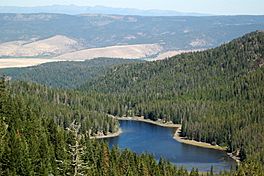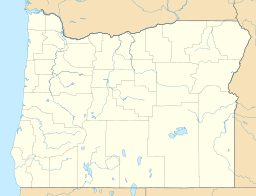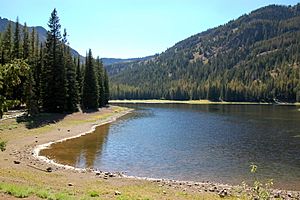Strawberry Lake (Oregon) facts for kids
Quick facts for kids Strawberry Lake |
|
|---|---|

View from the mountain
|
|
| Location | Grant County, Oregon |
| Coordinates | 44°18′25″N 118°41′00″W / 44.30694°N 118.68333°W |
| Type | Natural, permanent, oligotrophic |
| Primary inflows | Strawberry Creek |
| Primary outflows | Strawberry Creek |
| Catchment area | 3.5 square miles (9.1 km2) |
| Basin countries | United States |
| Surface area | 36 acres (15 ha) |
| Average depth | 9 feet (2.7 m) |
| Max. depth | 27 feet (8.2 m) |
| Water volume | 300 acre-feet (370,000 m3) |
| Residence time | 1 month |
| Shore length1 | 1.2 miles (1.9 km) |
| Surface elevation | 6,266 feet (1,910 m) |
| Settlements | Prairie City |
| 1 Shore length is not a well-defined measure. | |
Strawberry Lake is a beautiful natural lake high up in the mountains of Oregon, a state in the United States. It's part of the amazing Strawberry Mountain Wilderness. This shallow lake covers about 36 acres (150,000 m2) and is surrounded by thick forests. It's a popular spot for outdoor fun like hiking, camping, skiing, and fishing. You can find it about 10 miles (16 km) south of Prairie City in Grant County.
Contents
How Strawberry Lake Was Formed
Strawberry Lake is one of several small lakes in the Strawberry Mountain Wilderness. These lakes were created by glaciers long ago. The lake's surface is over 6,000 feet (1,800 m) above sea level.
The area around the lake was shaped by ancient volcanoes. About 14.7 million years ago, huge volcanoes erupted. They covered a large area with lava and mud. The Strawberry Mountains we see today are what's left of those old volcanoes.
Strawberry Lake sits in a valley carved out by ice during the Ice Age. It formed behind a natural dam made by a landslide across Strawberry Creek. Water from the lake usually seeps through this landslide. It then reforms the creek a bit further downstream.
Lake Size and Depth
Strawberry Lake is about 1.2 miles (1.9 km) around its shoreline. It has an average depth of 9 feet (2.7 m). The deepest part of the lake is about 27 feet (8.2 m) deep. Even with some activities happening nearby, the water is usually very clear. You can often see the bottom of the lake, even in its deepest spots!
A Bit of History
The name "Strawberry Lake" comes from a man named Nathan W. Fisk. He settled in this area in 1870. He noticed lots of wild strawberries growing there. So, he named nearby places like Strawberry Butte (now Strawberry Mountain) and Strawberry Creek after them. The name then spread to include Strawberry Valley and Strawberry Lake.
Fun Things to Do at Strawberry Lake
Strawberry Lake is a fantastic place for outdoor adventures.
Hiking and Camping
Many people enjoy hiking, backpacking, and camping near the lake. There's a campsite called Strawberry Camp about 1.3 miles (2.1 km) downstream from the lake. A hiking trail connects the camp to the lake.
The trail continues upstream from the lake for 1.2 miles (1.9 km) to Strawberry Falls. These falls are about 40 feet (12 m) tall! If you keep going another 0.6 miles (0.97 km), you'll reach Little Strawberry Lake. Another trail from Strawberry Falls leads 6.3 miles (10.1 km) up to the top of Strawberry Mountain.
Winter Sports
Even in winter, people visit the lake for fun. The main road to the wilderness area is not plowed. It gets blocked by snow about 2 to 4 miles (3.2 to 6.4 km) from Strawberry Camp. But brave adventurers can still reach the lake, the frozen Strawberry Falls, and Little Strawberry Lake. They do this by cross-country skiing or snowshoeing.
Fishing
Fishing is allowed in Strawberry Lake all year round. However, getting there can be tough in winter because of the snow. The lake is home to many brook trout. You can also find some rainbow trout there. These fish are present because they are regularly stocked in the lake.




